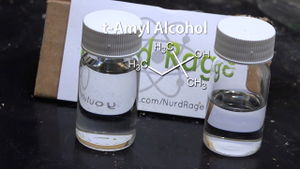Difference between revisions of "Tert-Amyl alcohol"
| (7 intermediate revisions by 3 users not shown) | |||
| Line 110: | Line 110: | ||
}} | }} | ||
}} | }} | ||
| − | '''''tert''-Amyl alcohol''' ('''TAA''') or '''2-methyl-2-butanol''', is | + | '''''tert''-Amyl alcohol''' ('''TAA''') or '''2-methyl-2-butanol''', is an isomer of [[pentanol]] and the second-smallest tertiary alcohol after the better-known [[tert-Butanol|''tert''-butanol]]. |
==Properties== | ==Properties== | ||
===Chemical=== | ===Chemical=== | ||
| − | ''tert''-Amyl alcohol, like all tertiary alcohols | + | ''tert''-Amyl alcohol, like all tertiary alcohols, is not readily oxidized. Due to the high stability of the tert-amyl cation, it is quite easy to prepare tert-amyl halides by reaction of the alcohol with the corresponding hydrogen halide at room temperature. |
===Physical=== | ===Physical=== | ||
| − | ''tert''-Amyl alcohol is a colorless liquid | + | ''tert''-Amyl alcohol is a colorless liquid with a camphor-like odor, often described as unpleasant. It is somewhat soluble in water, but miscible with other organic solvents, like alcohols and halocarbons. |
==Availability== | ==Availability== | ||
| − | ''tert''- | + | ''tert''-Pentanol is sold by chemical suppliers. Can also be bought online. |
| − | Can also be extracted via fractional distillation from fusel oil. | + | Can also be extracted via fractional distillation from fusel oil, though you will need large amounts of it. |
==Preparation== | ==Preparation== | ||
''tert''-Amyl alcohol can be prepared via the bromoethylethylmagnesium Grignard with [[acetone]] route. | ''tert''-Amyl alcohol can be prepared via the bromoethylethylmagnesium Grignard with [[acetone]] route. | ||
| + | |||
| + | NurdRage has a [https://www.youtube.com/watch?v=EFQWD7-DCPI good video on this process]. | ||
==Projects== | ==Projects== | ||
| − | *Preparation of metallic [[potassium]] | + | *Preparation of metallic [[potassium]] and [[sodium]] |
| − | + | ||
==Handling== | ==Handling== | ||
===Safety=== | ===Safety=== | ||
| − | ''tert''-Amyl alcohol is flammable and | + | ''tert''-Amyl alcohol is flammable and a skin irritant, though it's not very flammable in cold environment. |
| + | |||
| + | Ingestion or inhalation produces intoxication similar in many ways to ethanol, though it is around 20 times more potent by volume and produces longer-lasting effects. Exposure to vapor in the lab or accidental ingestion may cause temporary loss of physical and mental faculties or even sedation. | ||
===Storage=== | ===Storage=== | ||
| − | + | ''tert''-Amyl alcohol should be kept in closed bottles made of glass or chemically resistant plastic such as HDPE, preferably in a flammables cabinet. | |
===Disposal=== | ===Disposal=== | ||
| − | Can be safely burned. | + | Can be safely burned outside. Combustion products are not harmful. |
==References== | ==References== | ||
Latest revision as of 21:00, 12 September 2019
 Low purity forerun (left) and high purity end run (right) tert-amyl alcohol, obtained via Grignard reaction route.
| |
| Names | |
|---|---|
| IUPAC name
2-Methylbutan-2-ol
| |
| Other names
2-Methyl-2-butanol
2-Methyl-2-butyl alcohol Amylene hydrate Dimethylethylcarbinol TAA t-Amylol t-Pentylol tert-Amyl alcohol tert-Pentyl alcohol | |
| Properties | |
| C5H12O CH3CH2(CH3)2C(OH) | |
| Molar mass | 88.15 g/mol |
| Appearance | Colorless liquid |
| Odor | Camphor-like |
| Density | 0.8096 g/cm3 (20 °C) |
| Melting point | −9 °C (16 °F; 264 K) |
| Boiling point | 102.4 °C (216.3 °F; 375.5 K) |
| 12 g/100 ml | |
| Solubility | Miscible with acetone, diethyl ether, benzene, chloroform, ethanol, glycerol, oils |
| Vapor pressure | 1.6 kPa (at 20 °C) |
| Thermochemistry | |
| Std molar
entropy (S |
229.3 J·K−1·mol−1 |
| Std enthalpy of
formation (ΔfH |
−380.0–−379.0 kJ/mol |
| Hazards | |
| Safety data sheet | Sigma-Aldrich |
| Flash point | 19 °C (66 °F; 292 K) |
| Lethal dose or concentration (LD, LC): | |
| LD50 (Median dose)
|
1,000 mg/kg (rat, oral) |
| Related compounds | |
| Related compounds
|
tert-Butanol Pentanol |
| Except where otherwise noted, data are given for materials in their standard state (at 25 °C [77 °F], 100 kPa). | |
| Infobox references | |
tert-Amyl alcohol (TAA) or 2-methyl-2-butanol, is an isomer of pentanol and the second-smallest tertiary alcohol after the better-known tert-butanol.
Contents
Properties
Chemical
tert-Amyl alcohol, like all tertiary alcohols, is not readily oxidized. Due to the high stability of the tert-amyl cation, it is quite easy to prepare tert-amyl halides by reaction of the alcohol with the corresponding hydrogen halide at room temperature.
Physical
tert-Amyl alcohol is a colorless liquid with a camphor-like odor, often described as unpleasant. It is somewhat soluble in water, but miscible with other organic solvents, like alcohols and halocarbons.
Availability
tert-Pentanol is sold by chemical suppliers. Can also be bought online.
Can also be extracted via fractional distillation from fusel oil, though you will need large amounts of it.
Preparation
tert-Amyl alcohol can be prepared via the bromoethylethylmagnesium Grignard with acetone route.
NurdRage has a good video on this process.
Projects
Handling
Safety
tert-Amyl alcohol is flammable and a skin irritant, though it's not very flammable in cold environment.
Ingestion or inhalation produces intoxication similar in many ways to ethanol, though it is around 20 times more potent by volume and produces longer-lasting effects. Exposure to vapor in the lab or accidental ingestion may cause temporary loss of physical and mental faculties or even sedation.
Storage
tert-Amyl alcohol should be kept in closed bottles made of glass or chemically resistant plastic such as HDPE, preferably in a flammables cabinet.
Disposal
Can be safely burned outside. Combustion products are not harmful.